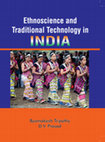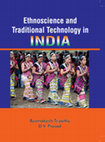Papers by Basanta K U M A R Mohanta
Aayu Publications, 2016
All rights are reserved. No part of this publication may be reproduced, stored in a retrieval sys... more All rights are reserved. No part of this publication may be reproduced, stored in a retrieval system or transmitted, in any form or by any means, mechanical, photocopying, recording or otherwise, without prior written permission of the publisher.
Aayu Publications, 2020
All rights are reserved. No part of this publication may be reproduced, stored in a retrieval sys... more All rights are reserved. No part of this publication may be reproduced, stored in a retrieval system or transmitted, in any form or by any means, mechanical, photocopying, recording or otherwise, without prior written permission of the author/publisher.
Anthropos India oaie:cts like: leather, u)ood., metal, ceramic etc. These craft, products are eco... more Anthropos India oaie:cts like: leather, u)ood., metal, ceramic etc. These craft, products are eco-friendlg, cheap and durable. This article descibes uqrious tgpes of crafi objects prepared bg the Nara people alang uith t?eir methods of preparation and use. Since th.e first author of this article belongs to the studied ethnic group and region, it was easg to collect ttrc releuant data bg means of participant obseruation and interuieuts, The persanal experiences and knouledge of ttte first autlnr are also contributed a lot to make this uork more uteightg.

Crafts or handicrafts are multipurpose handmade items. The term craft is also used to refer to th... more Crafts or handicrafts are multipurpose handmade items. The term craft is also used to refer to the art of making handicrafts. Handicrafts vary across cultures, and usually they are grouped into several types based on materials employed in their manufacture. Basketry, pottery, wood crafts, and leather crafts are some of the traditionally made articles. Other types of crafts include textile and fiber crafts, paper crafts, silver crafts, plastic crafts etc., and usually they involve mechanized instruments. The art of craft making is handed down from one generation to another in a form of practical experience; and the skill of craft making is preserved through continuous practice and application by the communities. The Nara people - one of the small ethnic groups of western Eritrea (North East Africa) retain a bulk of age-old traditional crafts and still produce many of these crafts. They prepare different daily use household objects like: leather, wood, metal, ceramic etc. These craft products are eco-friendly, cheap and durable. This article describes various types of craft objects prepared by the Nara people along with their methods of preparation and use. Since the first author of this article belongs to the studied ethnic group and region, it was easy to collect the relevant data by means of participant observation and interviews. The personal experiences and knowledge of the first author are also contributed a lot to make this work more weighty.

Ethno-science is one of the emerging field of enquiry in cognitive discipline generally deals wit... more Ethno-science is one of the emerging field of enquiry in cognitive discipline generally deals with the study of the systems of classification and taxonomies. It is also known as 'indigenous', or 'native' or 'traditional' science since it is completely based on native perceptions. It is an outcome of everyday practical experience with the nature by human beings. With its functional demands, it is changing constantly subjected to local, regional, national and global with the exposure to external interventions. The aim of ethno science is to gain a more complete description of cultural knowledge. Ethno science has been successful based on several studies of given cultures relating to their linguists, folk taxonomy, and how they classify their foods, animals and plants. Keeping in view of its significance, its focus is broadened now a days to embrace all areas of folk knowledge since it is base for the modern or western science. There exists a controversy at global level on the validity and reliability of local knowledge over the western or scientific knowledge. Despite of this fact, policy makers and planners do understood the role of traditional knowledge in the sustainable development. There might also be an unequal distribution of knowledge amongst a tribe or peoples. The role of governments, NGOs, grass root workers for research, protection and conservation of indigenous science has made to have a fresh look at some of the dichotomies and contested issues like undesired and outdated methods of native science. With this backdrop, the present book tries to covers the expertise of Ethnoscience of indigenous population in India like iron smelting and iron smithy, dokra (metal crafting), terra cotta artifacts, cane and bamboo crafts, bell metal, making musical instruments, masks, etc., since it is not only valuable cultural heritage but also a source of major livelihood. The present book also aims to explore the theoretical as well as empirical models and methods of traditional technology among the various tribes of India. To test the hypothesis i.e., importance of ethno science in livelihoods of tribal communities, an inter disciplinary academic effort is exercised since it is essential for cross exchange of ideas and experiences before its documentation for future generations. The level of this book is truly academic and research oriented. Further it is also useful to the planners, policy makers, administrators, and other action groups who are interested for protection of indigenous rights. This book had provided the scope to do further research on not only horticultural communities but other tribal communities since rejenuvation of environment is possible with them.
Languageisconsideredasthemirrorofasocietyandthescientificstudyof language is called r-g;rii.r. so... more Languageisconsideredasthemirrorofasocietyandthescientificstudyof language is called r-g;rii.r. som.etimel this language becemes an important aspect of a culture u'iJ ptly' an important role to identify a cultural group/ society, tribe, community, ethnic gto'P^t:-"tl' Eritrea is a small key shaped country'

Ethno-science is one of the emerging field of enquiry in cognitive discipline generally deals wit... more Ethno-science is one of the emerging field of enquiry in cognitive discipline generally deals with the study of the systems of classification and taxonomies. It is also known as 'indigenous', or 'native' or 'traditional' science since it is completely based on native perceptions. It is an outcome of everyday practical experience with the nature by human beings. With its functional demands, it is changing constantly subjected to local, regional, national and global with the exposure to external interventions. The aim of ethno science is to gain a more complete description of cultural knowledge. Ethno science has been successful based on several studies of given cultures relating to their linguists, folk taxonomy, and how they classify their foods, animals and plants. Keeping in view of its significance, its focus is broadened now a days to embrace all areas of folk knowledge since it is base for the modern or western science. There exists a controversy at global level on the validity and reliability of local knowledge over the western or scientific knowledge. Despite of this fact, policy makers and planners do understood the role of traditional knowledge in the sustainable development. There might also be an unequal distribution of knowledge amongst a tribe or peoples. The role of governments, NGOs, grass root workers for research, protection and conservation of indigenous science has made to have a fresh look at some of the dichotomies and contested issues like undesired and outdated methods of native science. With this backdrop, the present book tries to covers the expertise of Ethnoscience of indigenous population in India like iron smelting and iron smithy, dokra (metal crafting), terra cotta artifacts, cane and bamboo crafts, bell metal, making musical instruments, masks, etc., since it is not only valuable cultural heritage but also a source of major livelihood. The present book also aims to explore the theoretical as well as empirical models and methods of traditional technology among the various tribes of India. To test the hypothesis i.e., importance of ethno science in livelihoods of tribal communities, an inter disciplinary academic effort is exercised since it is essential for cross exchange of ideas and experiences before its documentation for future generations. The level of this book is truly academic and research oriented. Further it is also useful to the planners, policy makers, administrators, and other action groups who are interested for protection of indigenous rights. This book had provided the scope to do further research on not only horticultural communities but other tribal communities since rejenuvation of environment is possible with them.











Uploads
Papers by Basanta K U M A R Mohanta